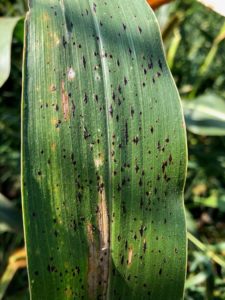By Brayden Evans
AgVenture Product Marketing Intern
Tar spot is a disease found in corn that can lead to significant yield losses if not properly managed. Tar spot is caused by a fungus called Phyllachora maydis that can spread throughout corn fields in the Midwest. This disease was first found in 2015, but has quickly spread throughout Iowa, Illinois, Indiana, Minnesota, Wisconsin, Ohio, Michigan, and Missouri.
The map on the right shows the current location of tar spot as of July 2022. To track the current spread of tar spot, click here. Tar spot was first confirmed in 2022 in Marshall County, Iowa, on June 30, 2022, on V11 corn with low incidence (approximately 1% plants with signs), according to Iowa State’s ICM blog. Tarspotter forecasts Marshall County, as well as most of Iowa, at a high risk for tar spot.
“For some growers, it may seem like tar spot has been around forever, but it’s still a relatively new disease to the Corn Belt,” said Darren Bakken, AgVenture Corn Product Lead. “We’ll continue to improve our knowledge of genetic resistance in our germplasm.”
Tar spot appears as small, raised, black spots dispersed across leaf surfaces. The spots are ascomatum, known as fungal fruiting structures. The disease tends to appear when there are long periods of high relative humidity and leaf wetness. They cause corn plants to have reduced photosynthesis leading to less energy for plant and ear growth. Tar spot can cause a reduction in yield of up to 20 to 40 bushels per acre. With a high yield reduction, it makes it important to scout fields and monitor disease pressure. However, tar spot can be confused with common or southern rust later in the season, but tar spot cannot be scraped off leaf surfaces.
There are multiple ways to manage tar spot and maintain your yield potential. “Planting hybrids with some level of resistance is one of your best management options,” said Bakken. “All hybrids are susceptible to tar spot, but some show more resistance than others. We have initial tar spot ratings on several of our commercially available AgVenture brand hybrids.”
Bakken also recommends utilizing the Tarspotter app, available for Apple and Android devices. University research has indicated that the appearance of tar spot fungus can be predicted using several variables, including weather. Based on this research, models have been developed to forecast Tar spot risk. By inputting site-specific information into the app, farmers can use research models to predict the best timing for tar spot treatment.

Phyllachora maydis, the fungus that causes tar spot, produces stromata that can be slightly raised, black, and often observed on leaves of affected corn plants.
Tar spot pathogens overwinter on infected corn residue. With the use of residue management to break down corn leaves, the disease host is significantly reduced. Crop rotation and avoiding planting susceptible hybrids can reduce disease severity.
Proper fungicide applications can also be used to effectively control tar spot outbreaks when applied between VT and R2 stages. Cutting Edge Consulting Agronomist, Jerry Hartsock, says, “A one or two-phase attack with fungicides can be the answer to keep the disease to a minimum. There is the need for a primo product at the R1 targeted fungicide application to provide longevity and optimize yield through stress alleviation.” Research at the University of Wisconsin has shown spraying fungicides with multiple modes of action has worked best against tar spot.
We know that every operation is different, so we recommend talking to your local AgVenture Yield Specialist to develop a comprehensive fungicide plan and determine the best AgVenture brand corn hybrids for your operation.

